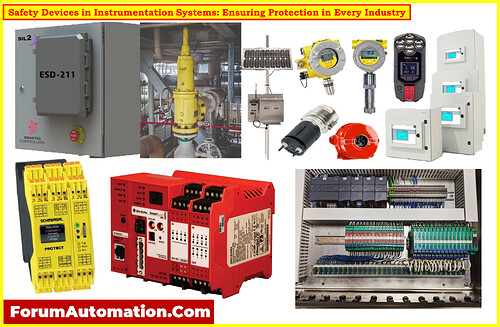What are some of the different types of safety devices used in instrumentation systems?
- In order to safeguard persons, processes, and equipment from potential risks, safety devices are essential parts of instrumentation systems.
- They serve in making sure the system functions safely and is capable of handling unusual circumstances.
- In many industries, including the oil and gas, chemical, power generating, food and beverage, and more, safety devices are essential components.
- They are essential in preventing harm to people, property, and the environment.
- It is crucial to take into account the precise risks that must be reduced as well as the required safety integrity level (SIL), which establishes the degree of reliability and performance required for ensuring safety, while choosing safety devices for instrumentation systems.
- In order to keep these systems safe and reliable, compliance with safety laws and regulations is also necessary.
- The following are a few varieties of safety devices that are frequently seen in instrumentation systems:
Emergency Shutdown Systems (ESD)
- ESD systems are designed to rapidly shut down or isolate a process or system in the event of a critical failure or hazardous condition. This can include shutting off valves, pumps, and electrical power to prevent accidents or damage.
Pressure Relief Valves
- Pressure relief valves are used to prevent over-pressurization in vessels, pipelines, and systems. They automatically release excess pressure, protecting the system from potential explosions or ruptures.
Flame and Gas Detectors
- These sensors detect the presence of flammable gases or flames and trigger alarms or shutdown systems to prevent fires and explosions.
Temperature Limit Controllers
- Temperature limit controllers monitor temperature and take action to prevent overheating or excessive cooling, ensuring that processes stay within safe temperature ranges.
Safety Controllers
- These controllers are designed to monitor a process for safety-related conditions and take appropriate action to prevent a hazardous situation.
Safety PLCs (Programmable Logic Controllers)
- These PLCs are specifically designed for safety applications and have features such as redundancy, self-diagnostics, and fail-safe operation.
Interlocks and Safety Interposing Relays
- Interlocks and safety relays are used to enforce safe sequences of operation, preventing unsafe conditions or actions by ensuring that specific conditions are met before allowing a system to operate.
Fire Suppression Systems
- These systems automatically detect and suppress fires using various methods, such as releasing fire-extinguishing agents, to safeguard equipment and facilities.
Emergency Ventilation and Gas Scrubbers
- In areas with potential gas leaks or toxic fumes, emergency ventilation and gas scrubbing systems help remove harmful gases and maintain safe air quality.
Intrinsically Safe Barriers
- These barriers limit electrical energy to safe levels in hazardous areas to prevent the risk of ignition or explosion due to electrical sparks.
Safety Instrumented Systems (SIS)
- SIS are dedicated control systems that monitor critical parameters and take safety actions when certain conditions are exceeded, providing multiple layers of protection.
Safety Relief Devices
- These devices, including burst discs and pressure safety valves, protect pressure vessels and pipelines by releasing pressure to prevent over-pressurization.
Ground Fault Circuit Interrupters (GFCI)
- GFCIs are used to detect ground faults and provide electrical shock protection in damp or wet environments.
Lockout/Tagout (LOTO)
- LOTO procedures involve locking and tagging equipment and energy sources to prevent accidental or unauthorized operation during maintenance or servicing.
Safety Signage and Labels
- Clear and standardized safety signs and labels help communicate hazards, emergency procedures, and safety precautions to personnel.
